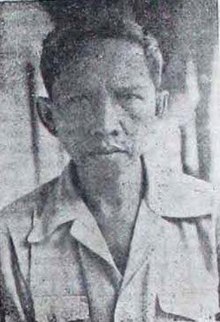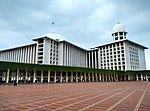Sekarmadji Maridjan Kartosoewirjo
This article includes a improve this article by introducing more precise citations. (May 2015) ) |
Soekarmadji Maridjan Kartosuwiryo | |
|---|---|
 | |
| Imam of the Islamic State of Indonesia | |
| In office 7 August 1949 – 4 June 1962 | |
| Preceded by | position created |
| Succeeded by | position abolished |
| Personal details | |
| Born | 7 January 1905 Cepu, Dutch East Indies |
| Died | 5 September 1962 (age 57) Kepulauan Seribu, Jakarta, Indonesia |
| Cause of death | Execution by firing squad |
| Spouse | Dewi Siti Kalsum |
| Signature |  |
Soekarmadji Maridjan Kartosuwiryo (7 January 1905 – 5 September 1962) was an Indonesian Islamic mystic who led the Darul Islam rebellion against the Indonesian government from 1949 to 1962, intending to overthrow the secular Pancasila ideology and establish Negara Islam Indonesia (Islamic State of Indonesia) based on sharia law.
Early life
Kartosuwiryo was born in
While touring Malangbong, near Garut in West Java, Kartosuwiryo met and married the daughter of a local PSII leader. He settled down in this area, where he established a madrasa. In 1937, he resigned from PSII to establish his political movement advocating a future Islamic State of Indonesia based on Islamic law.
Leading the Darul Islam
During the
On 7 August 1949, he declared the establishment of
During the 1950s, a weak central government and uncoordinated military response from the government allowed Darul Islam to flourish, controlling one-third of West Java and even launching raids as far as the outskirts of Jakarta. Islamic rebels in South Sulawesi and Aceh joined Darul Islam and acknowledged Kartosuwiryo as their highest authority though in practice there was little coordination between the rebels in the different provinces. In 1957, agents sent by Kartosuwiryo unsuccessfully attempted to assassinate Sukarno with a grenade attack during a primary school function at Cikini, Central Jakarta.
Defeat and death
The declaration of martial law in 1957 and the establishment of Guided Democracy by Sukarno in 1959 proved to be a turning point for Darul Islam's fortunes. The military introduced the effective "fence of legs" method to encircle the guerillas' mountain bases and cut off their supply and escape routes, forcing the rebels to surrender or face annihilation in the face of superior firepower. Kartosuwiryo responded by declaring "total war" in 1961, in which Darul Islam guerillas increasingly used terror tactics and banditry against civilians, further alienating the population. He also sent agents to Jakarta, where in May 1962 they made another unsuccessful assassination attempt on Sukarno during the Eid al-Adha prayers. In June 1962, Kartosuwiryo was eventually captured in his hideout at Mount Geber near
References
Further reading
- Dijk, C. van (Cornelis) Rebellion under the banner of Islam : the Darul Islam in Indonesia The Hague: M. Nijhoff,1981.ISBN 90-247-6172-7
- Kilcullen, David "The political consequences of military operations in Indonesia 1945-99 : a fieldwork analysis of the political power-diffusion effects of guerilla conflict " PhD Thesis, University of New South Wales - Australian Defence Force Academy. School of Politics, 2000

